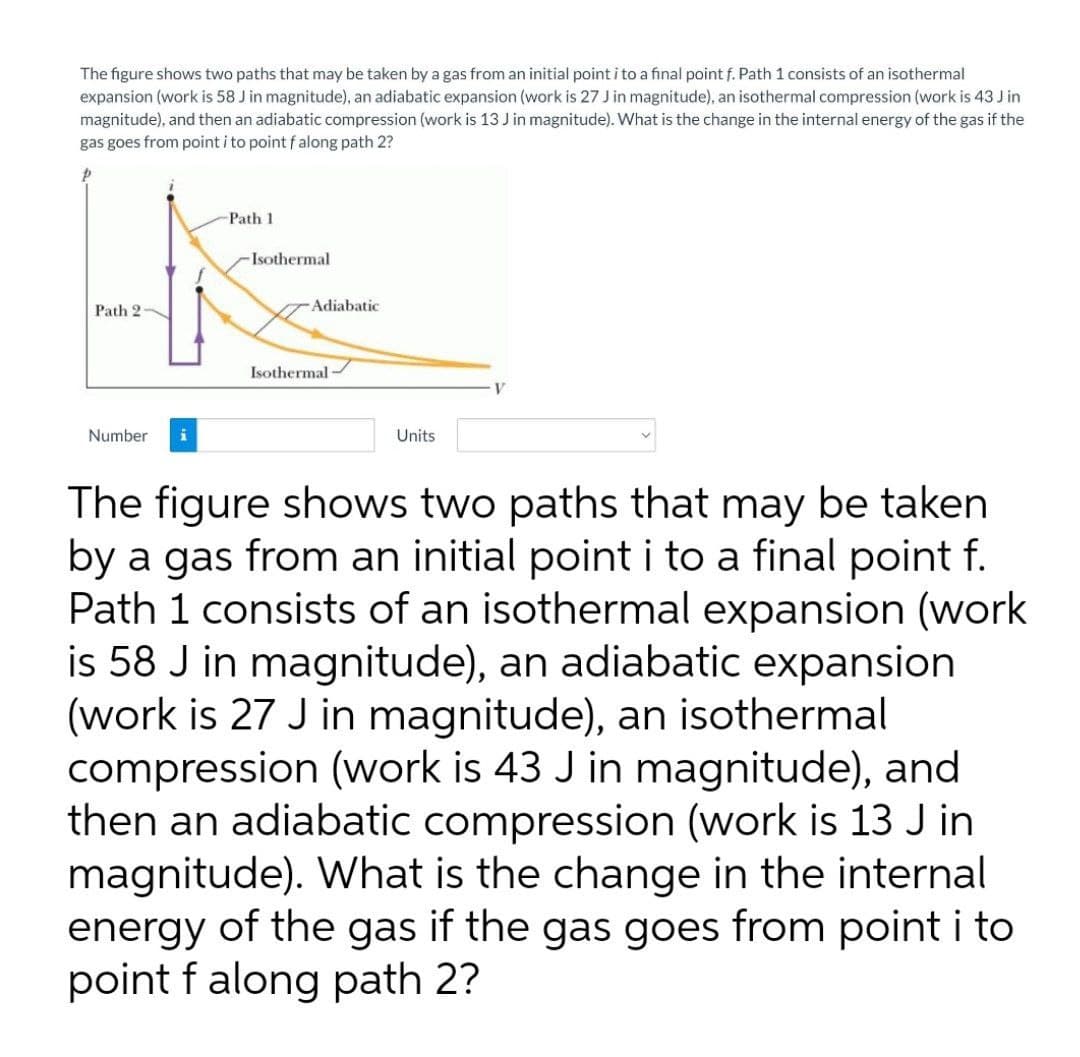The figure shows two paths that may be taken by a gas from an initial point i to a final point f. Path 1 consists of an isothermal expansion (work is 58 J in magnitude), an adiabatic expansion (work is 27 J in magnitude), an isothermal compression (work is 43 Jin magnitude), and then an adiabatic compression (work is 13 J in magnitude). What is the change in the internal energy of the gas if the gas goes from point i to point falong path 2? Path 1 Isothermal Path 2 Adiabatic
The figure shows two paths that may be taken by a gas from an initial point i to a final point f. Path 1 consists of an isothermal expansion (work is 58 J in magnitude), an adiabatic expansion (work is 27 J in magnitude), an isothermal compression (work is 43 Jin magnitude), and then an adiabatic compression (work is 13 J in magnitude). What is the change in the internal energy of the gas if the gas goes from point i to point falong path 2? Path 1 Isothermal Path 2 Adiabatic
Principles of Physics: A Calculus-Based Text
5th Edition
ISBN:9781133104261
Author:Raymond A. Serway, John W. Jewett
Publisher:Raymond A. Serway, John W. Jewett
Chapter17: Energy In Thermal Processes: The First Law Of Thermodynamics
Section: Chapter Questions
Problem 47P
Related questions
Question
answer quickly

Transcribed Image Text:The figure shows two paths that may be taken by a gas from an initial point i to a final point f. Path 1 consists of an isothermal
expansion (work is 58 J in magnitude), an adiabatic expansion (work is 27 J in magnitude), an isothermal compression (work is 43 J in
magnitude), and then an adiabatic compression (work is 13 J in magnitude). What is the change in the internal energy of the gas if the
gas goes from point i to point falong path 2?
Path 1
Isothermal
Path 2-
Adiabatic
Isothermal
Number
Units
The figure shows two paths that may be taken
by a gas from an initial point i to a final point f.
Path 1 consists of an isothermal expansion (work
is 58 J in magnitude), an adiabatic expansion
(work is 27 J in magnitude), an isothermal
compression (work is 43 J in magnitude), and
then an adiabatic compression (work is 13 J in
magnitude). What is the change in the internal
energy of the gas if the gas goes from point i to
point f along path 2?
Expert Solution
This question has been solved!
Explore an expertly crafted, step-by-step solution for a thorough understanding of key concepts.
Step by step
Solved in 3 steps

Recommended textbooks for you

Principles of Physics: A Calculus-Based Text
Physics
ISBN:
9781133104261
Author:
Raymond A. Serway, John W. Jewett
Publisher:
Cengage Learning

Physics for Scientists and Engineers: Foundations…
Physics
ISBN:
9781133939146
Author:
Katz, Debora M.
Publisher:
Cengage Learning

Physics for Scientists and Engineers, Technology …
Physics
ISBN:
9781305116399
Author:
Raymond A. Serway, John W. Jewett
Publisher:
Cengage Learning

Principles of Physics: A Calculus-Based Text
Physics
ISBN:
9781133104261
Author:
Raymond A. Serway, John W. Jewett
Publisher:
Cengage Learning

Physics for Scientists and Engineers: Foundations…
Physics
ISBN:
9781133939146
Author:
Katz, Debora M.
Publisher:
Cengage Learning

Physics for Scientists and Engineers, Technology …
Physics
ISBN:
9781305116399
Author:
Raymond A. Serway, John W. Jewett
Publisher:
Cengage Learning
